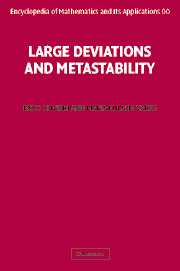Book contents
- Frontmatter
- Contents
- Preface
- 1 Large deviations: basic results
- 2 Small random perturbations of dynamical systems. Basic estimates of Freidlin and Wentzell
- 3 Large deviations and statistical mechanics
- 4 Metastability. General description. Curie–Weiss model. Contact process
- 5 Metastability. Models of Freidlin and Wentzell
- 6 Reversible Markov chains in the Freidlin–Wentzell regime
- 7 Metastable behaviour for lattice spin models at low temperature
- References
- Index
7 - Metastable behaviour for lattice spin models at low temperature
Published online by Cambridge University Press: 13 August 2009
- Frontmatter
- Contents
- Preface
- 1 Large deviations: basic results
- 2 Small random perturbations of dynamical systems. Basic estimates of Freidlin and Wentzell
- 3 Large deviations and statistical mechanics
- 4 Metastability. General description. Curie–Weiss model. Contact process
- 5 Metastability. Models of Freidlin and Wentzell
- 6 Reversible Markov chains in the Freidlin–Wentzell regime
- 7 Metastable behaviour for lattice spin models at low temperature
- References
- Index
Summary
Introduction
In this chapter we discuss metastability and nucleation for several short range lattice spin systems at low temperature. We already analysed the case of the Curie–Weiss model in Chapter 4. Due to the fact that the intermolecular interaction does not decay at infinity, the Curie–Weiss model exhibits a mean field behaviour without any spatial structure; the configurations are well described, especially for large volumes, by the values of a unique macroscopic order parameter, i.e. the magnetization, so that the configuration space becomes one-dimensional. In contrast, for short range stochastic Ising models the geometrical aspects are particularly relevant. In this last case the configuration space can be viewed as a space of families of contours and it tends to be infinite dimensional in the thermodynamic limit. Indeed it is well known that the description of pure coexisting equilibrium phases at low temperature is naturally given in terms of a gas of contours (see Chapter 3, proof of Proposition 3.30, and [280]). It is clear that in the analysis of dynamical phenomena taking place in large finite systems, the geometrical description in terms of contours will also play a relevant role.
The central question in the description of the decay from a metastable to a stable phase for short range stochastic Ising models is, in addition to determination of the typical escape time, the characterization of the typical ‘nucleation pattern’ namely the typical sequences, in shape and size, of droplets along which nucleation of the stable phase takes place.
- Type
- Chapter
- Information
- Large Deviations and Metastability , pp. 399 - 492Publisher: Cambridge University PressPrint publication year: 2005

